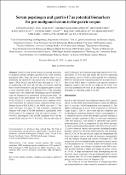Options
Serum pepsinogen and gastrin-17 as potential biomarkers for pre-malignant lesions in the gastric corpus
Journal
Biomedical Reports
Date Issued
2017
Author(s)
Loong, TH
Soon, NC
Mahmud, NRKN
Naidu, J
Rani, RA
Elias, MH
Rose, IM
Tamil, A
Mokhtar, NM
Ali, RAR
DOI
10.3892/br.2017.985
Abstract
There is a lack of non-invasive screening modalities to diagnose chronic atrophic gastritis (CAG) and intestinal metaplasia (IM). Thus, the aim of the present study was to determine the sensitivity and specificity of serum pepsinogen I (PGI), PGI: II, the PGI: II ratio and gastrin-17 (G-17) in diagnosing CAG and IM, and the correlations between these serum biomarkers and pre-malignant gastric lesions. A cross-sectional study of 72 patients (82% of the calculated sample size) who underwent oesophagealgastro-duodenos-copy for dyspepsia was performed in the present study. The mean age of the participants was 56.2 +/- 16.2 years. Serum PGI: I, PGI: II, G-17 and Helicobacter pylori antibody levels were measured by enzyme-linked immunosorbent assay. Median levels of PGI: I, PGI: II, the PGI: II ratio and G-17 for were 129.9 mu g/l, 10.3 mu g/l, 14.7 and 4.4 pmol/l, respectively. Subjects with corpus CAG/IM exhibited a significantly lower PGI: II ratio (7.2) compared with the control group (15.7; P< 0.001). Histological CAG and IM correlated well with the serum PGI: II ratio (r=-0.417; P<0.001). The cut-off value of the PGI: II ratio of <= 10.0 demonstrated high sensitivity (83.3%), specificity (77.9%) and area under the receiver operating characteristic curve of 0.902 in detecting the two conditions. However, the sensitivity was particularly low at a ratio of <= 3.0. The serum PGI: II ratio is a sensitive and specific marker to diagnose corpus CAG/IM, but at a high cut-off value. This ratio may potentially be used as an outpatient, non-invasive biomarker for detecting corpus CAG/IM.
File(s)
Loading...
Name
Serum pepsinogen and gastrin‑17 as potential biomarkers for pre‑malignant lesions in the gastric corpus.pdf
Size
475.26 KB
Format
Adobe PDF
Checksum
(MD5):ec4b821990524801f1d2f3d56f6adb44